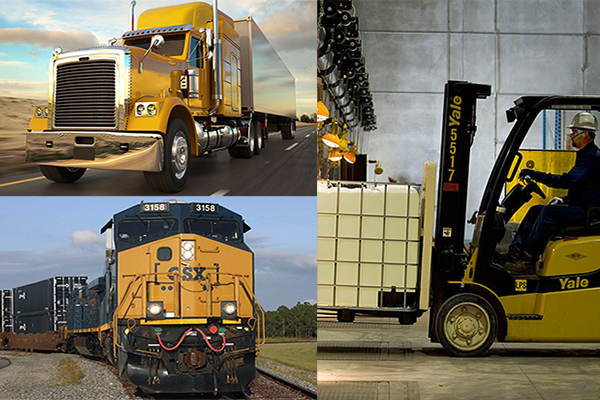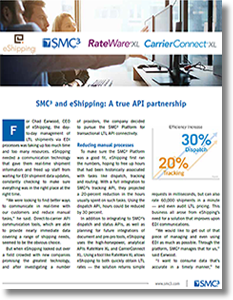Taking Advantage of 2018 Truckload, Less-than-Truckload, and Intermodal Strategies

Learn more about what's influencing your truckload, less-than-truckload, and Intermodal surface transportation strategies in 2018 and how to overcome the challenges.
Supply chains are not limited by a specific mode or service.
Freight migrates from one service to the next in the broad freight economy, seeking where it is served best.
Accordingly, we now need to watch trends in a multitude of services to best understand what is affecting each service and be open to change if necessary.
In this article, we’ll look at three surface transportation services, less-than-truckload (LTL), intermodal service, and full truckload to see what’s really happening in the market today.
Using this information could help you adapt quickly to changing market conditions.
A CLOSE LOOK AT LTL CONDITIONS
Operating in the LTL space today likely comes with significant challenges.
Increased demand for LTL
The ATA probably shows it best in this graph, but essentially, demand for LTL is higher than we’ve seen it in nearly 10 years.
This shift is especially significant change when paired with supply changes.
Both manufacturing and ecommerce are extremely strong right now and both have close ties to LTL.
Less-than-Truckload Supply/Demand

Source: American Trucking Association, Stifel estimates; data through November 2017
Online orders are driving smaller shipments to the LTL space. And not just in the final mile area either, but smaller orders are becoming more common for the middle mile - from one distribution center to another.
Limits to LTL capacity
Off the bat, LTL capacity is tight because carriers have not added a significant amount of equipment to their fleets in recent years. But even if there was an influx of tractors, there aren’t enough drivers available.
Historically, the driver shortages that affected the truckload market remained mostly out of the LTL space, but even that is changing. Growth in other sectors that have a shared labor force with truck drivers (e.g., construction, manufacturing, and oil fields) mean more LTL drivers are leaving for options that are more lucrative.
Carriers are optimizing networks
As LTL carriers look to be more productive, we’re seeing carriers placing a large emphasis on optimizing their networks. With the data, analytics, and tools like dimensionalizers available to them, LTL carriers are paying more attention to accepting the right freight in the right lanes at the right time. More isn’t absolutely better anymore.
INTERMODAL SERVICE IS SET TO GROW
The intermodal industry is forecasted to grow 6-9% over 2018 and 2019. Operating in this space is mostly positive, but not without challenges:
Potentially positive outlook for intermodal drivers
Typically, dray routes have been a positive landing spot for drivers - home every night, solid experience, etc. But driver pay for dray shipments is lower than other types of deliveries. Accordingly, like LTL and truckload, carriers are losing drivers to shared labor pools where they can make more money.
Inventory management is key
When it comes to consistent deliveries of products or speed of delivery, we’re seeing more shippers look for the consistent and reliable deliveries. Intermodal is a great opportunity for this, but the added time in transit tends to require tighter control over inventory to offset shipping times.
New dray service times due to ELDs
It has always remained true of intermodal service that the closer you are to ramps (at both pickup and destination), the better the price will be. That’s still true today. But the electronic logging device (ELD) mandate is causing some freight to take longer to move than before.
Read: Electronic Logging Device Mandate Adds to Truck Driver Shortage Woes
WHAT TO EXPECT WITH TRUCKLOAD SERVICE
Perhaps most influenced by the ELD mandate, the full truckload space is certainly in flux:
HOS haven’t changed, but flexibility has
It’s true that hours of service (HOS) haven’t changed. However, ELDs have eliminated any flexibility drivers may previously have taken with paper logs. For the first time, lane waste and efficiency are being documented on a massive scale. We’re learning that congestion is just one area that’s more impactful on drive time than we imagined.
Plan differently for 400-700 mile routes
As flexibility diminishes, you need to plan differently for “tweener” shipments - loads between 400 and 700 miles. While drivers are on the clock for 10 hours, we’re learning that congestion and wait times mean that only 7-8 hours are actually spent driving. This may mean that a shipment that was previously one-day transit time becomes two, and rates may need to shift accordingly so carriers can earn the revenue per day needed to be at healthy financial levels. Flexibility in scheduling - at both the origin and destination - may be one way to combat this.
Equipment utilization is near 100%
Because of ELDs, carriers are rebalancing their portfolios with the goal of increasing fleet yield. The only way they can stay profitable is by increasing productivity (revenue generating miles and hours) while remaining appealing to drivers. And since FTR estimates that equipment utilization is near 100%, we can expect rates to fluctuate until we establish a new normal.
HOW TO HANDLE THESE CHANGES
The trends we’re seeing in each mode are having a similar effect across all services - namely higher rates and tighter capacity. That’s why it’s more important than ever to align your goals with your transportation provider’s goals. Being a favored shipper will continue to pay off.
Source: C.H. Robinson Blog
Related: Transportation and Logistics CEOs Discuss Various Industry Issues at SMC³ Jump Start 2018
Related Resources
Why eShipping Selected the SMC³ Platform for Transactional LTL API Connectivity New!
In this case study, Chad Earwood, CEO of eShipping, describes how they integrated the SMC³ platform for transactional LTL API connectivity, and by using the analytical APIs RateWare XL and CarrierConnect XL they are able to obtain immediate LTL rates and audit LTL pricing. Download Now!
Improving Packaging: The Cost of Shipping Air is Going Up
Retailers and Manufacturers that insist on using inefficient and sloppy packaging methods - oversized boxes, inefficient packaging, poorly constructed palletized contents - are paying for their mistakes in sharply higher freight rates. Download Now!
Practical Steps for Highway to Intermodal Rail
Learn how to increase access to capacity, reduce transportation costs and mitigate exposure to future trucking regulations. Download Now!
More: Less-than-Truckload Papers
Article Topics
CSX News & Resources
Signs of progress are being made towards moving cargo in and out of Baltimore Top CSX executive places a sharp emphasis on railroading as a career path and service at NEARS Intermodal innovation? Crisis averted on U.S. railroads, with carriers and unions reaching tentative agreements CSX’s acquisition of Pan Am Railways is a done deal Baltimore breaks ground for double-stacking 126-year-old tunnel in ‘absolute game-changer’ CSX executive discusses railroad trends and themes at NEARS conference More CSXLatest in Transportation
Talking Supply Chain: Doomsday never arrives for Baltimore bridge collapse impacts Amazon Logistics’ Growth Shakes Up Shipping Industry in 2023 Nissan Channels Tesla With Its Latest Manufacturing Process Why are Diesel Prices Climbing Back Over $4 a Gallon? Luxury Car Brands in Limbo After Chinese Company Violates Labor Laws The Three Biggest Challenges Facing Shippers and Carriers in 2024 Supply Chain Stability Index: “Tremendous Improvement” in 2023 More Transportation

















